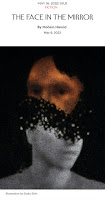Had to read this excellent except from Mohsin Hamid's upcoming novel ('The Last White Man', expected August 2022) has been published in The New Yorker on May 9, 2022, as 'The Face in the Mirror'. The author is quite the global citizen, and his sharp insights into how race sentiments in the United States have changed and shifted over the past two decades are on point, and a tad painful.
The entire premise of this story, and how the future is envisioned is not easy to pen down. It isn't a matter of a post-apocalyptic world. It's a matter of 'race as a construct', and how race is perceived by global citizens across all colors.
Anders woke up one morning and discovered that he's no longer white. He is now brown. Something is turning white people in this town dark and brown. In this entire notion, stereotypes are sharply noted. The townspeople are spooked, and militia groups are formed; the police didn't stop them from walking the streets possibly armed. Militants began running these 'turned' dark people out of town, people that one might know and who had been childhood friends.
Anders’s boss had said he would have killed himself, and the following week a man in town did just that, his story followed by Anders in the local press, or rather online in the regional section of a large publication, the local paper having shut down long ago, this man shooting himself in front of his own house, a shooting heard but not seen by a neighbor, and called in, and assumed to be an act of home defense, the dark body lying there that of an intruder, shot with his own gun after a struggle, but the homeowner was not present, and was nowhere to be found, and then the wedding ring and the wallet and the phone on the dead man were all tallied up, and the messages that had been sent, and the experts weighed in, and the sum of it all was clear, in other words, that a white man had indeed shot a dark man, but also that the dark man and the white man were the same.
Anders retreated to hide in his father's home. His father isn't well, and has taken to staying home most of the time. He hid out there for weeks, and finally ventured one day to get painkillers for his father. That day, he realized that most of the townspeople are now dark. Things didn't feel so hostile and antagonistic anymore. Stores were open, and services hummed as per normal. It's a majority-dark people town.
The excerpt also touched on Anders and his relationship with his father, as a child, and now. Was there redemption? I don't know. It simply shows us the relationship as of now, how adults handle it — either it never gets resolved, or it's simply brushed away as water under the bridge. When his father passed, Anders was stunned to realize that the father was the last pale man in town.
Anders had thought he would hate the funeral service but he did not hate the funeral service, it was comforting to be with these other people who came to offer their respects, and Anders did not know who was who and which was which, not until they introduced themselves, although occasionally he could guess, and there were not many of them, but there were enough, the right number, all those who were present being those who cared, and the ceremony did what it was meant to do, which was to make real what had happened and to weave Anders and those others left behind into a shared web of what they had lost, and Anders’s pale father was the only pale person present, the only pale person left in the entire town, for there were by that point no others, and then his casket was closed and his burial was occurring and he was committed to the soil, the last white man, and after that, after him, there were none.
In an interview about this book also done in May 2022 by The New Yorker's Cressida Leyshon, the question asked,
Anders’s father is the last white man of the novel’s title. With his death, everyone who lives in Anders’s town is dark. Will that new homogeneity simplify life for Anders and his fellow-citizens?The British-Pakistani author responded,
I don’t think that a town where people are not being perceived in racial terms is a more homogeneous town. In fact, the opposite: I think that race is an imagined construct that flattens people. Why would we want such a construct? Who benefits from having such a construct? Race simplifies, often in binary terms. It’s the original zero/one, the original binary code. It’s machine language, sorting language, for the most important commodity: human beings. People are far too complex for that algorithm to do anything but harm. That said, we can’t just say, “There’s no race anymore. Move on.” Entire societies have been built upon ideas of race. So we have to imagine our way out of it, excavate our way out of it, and over generations grow our way out of it, because much of human cultural development happens as one generation passes on and another grows up. It’s slow work. But, in the end, it isn’t all that important what I think. As a writer, I build environments out of words that readers enter and make their own—and in that process puzzle out a bit of what it is they think. What might it feel like to live in a town that undergoes the transformation that Anders’s town undergoes? You have asked the writer that question. The novel asks the reader.

No comments:
Post a Comment